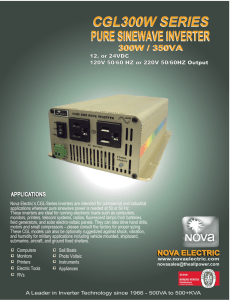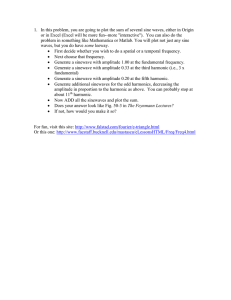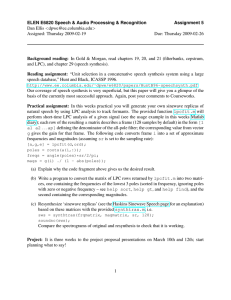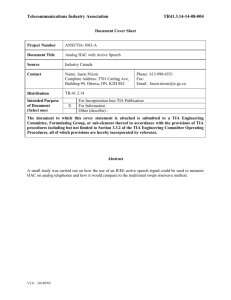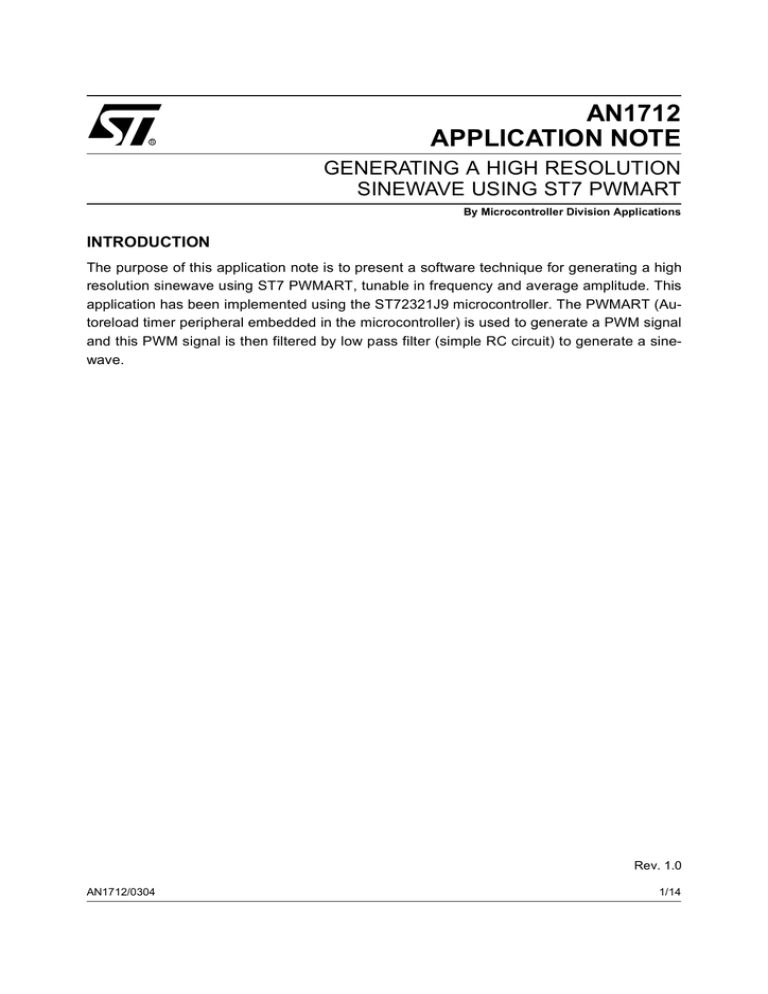
AN1712
APPLICATION NOTE
GENERATING A HIGH RESOLUTION
SINEWAVE USING ST7 PWMART
By Microcontroller Division Applications
INTRODUCTION
The purpose of this application note is to present a software technique for generating a high
resolution sinewave using ST7 PWMART, tunable in frequency and average amplitude. This
application has been implemented using the ST72321J9 microcontroller. The PWMART (Autoreload timer peripheral embedded in the microcontroller) is used to generate a PWM signal
and this PWM signal is then filtered by low pass filter (simple RC circuit) to generate a sinewave.
Rev. 1.0
AN1712/0304
1/14
1
GENERATING A HIGH RESOLUTION SINEWAVE USING ST7 PWMART
1 GENERATING A SINUSOID
This section highlights the main features of the ST7 PWMART used to generate a PWM signal
which is then filtered by low pass filter (a simple RC circuit in this example) to generate a sinusoid. Please refer to the ST7 datasheet for more details.
The ST7 PWMART consists of an 8-bit auto reload counter with compare/capture capabilities
and a 7-bit clock prescaler.
1.1 PWM GENERATION
The free running 8-bit counter is fed by the output of the prescaler, and is incremented on
every rising edge of the clock signal. It is possible to read or write the contents of the counter
on the fly by reading or writing the Counter Access register (ARTCAR). When a counter overflow occurs, the counter is automatically reloaded with the contents of the ARTARR register
(the prescaler is not affected).
The counter clock frequency is given by:
fCOUNTER=
fINPUT
2CC[2:0]
The timer counter’s input clock (fINPUT) feeds the 7-bit programmable prescaler, which selects
one of the 8 available taps of the prescaler, as defined by CC[2:0] bits in the ARTCSR Register. Thus the division factor of the prescaler can be set to 2n (where n = 0, 1,..7). This fINPUT
frequency source is selected through the EXCL bit of the ARTCSR register and can be either
the fCPU or an external input frequency fEXT. The clock input to the counter is enabled by the
TCE (Timer Counter Enable) bit in the ARTCSR register. When TCE is reset, the counter is
stopped and the prescaler and counter contents are frozen. When TCE is set, the counter runs
at the rate of the selected clock source.
The timer compare function is based on four different comparisons with the counter (one for
each PWMx output). Each comparison is made between the counter value and an output compare register (OCRx) value. This OCRx register can not be accessed directly, it is loaded from
the duty cycle register (PWMDCRx) at each overflow of the counter.
This double buffering method avoids glitch generation when changing the duty cycle on the fly.
PWM mode allows up to four Pulse Width Modulated signals to be generated on the PWMx
output pins with minimum core processing overhead. This function is stopped during HALT
mode. Each PWMx output signal can be selected independently using the corresponding OEx
bit in the PWM Control register (PWMCR). When this bit is set, the corresponding I/O pin is
2/14
2
GENERATING A HIGH RESOLUTION SINEWAVE USING ST7 PWMART
configured as output push-pull alternate function. The PWM signals all have the same frequency which is controlled by the counter period and the ARTARR register value.
fCOUNTER
fPWM=
256 - ARTARR
When a counter overflow occurs, the PWMx pin level is changed depending on the corresponding OPx (output polarity) bit in the PWMCR register. When the counter reaches the
value contained in one of the output compare register (OCRx) the corresponding PWMx pin
level is restored.
Note: The reload values will also affect the value and the resolution of the PWM output signal
duty cycle. To obtain a signal on a PWMx pin, the contents of the OCRx register must be
greater than the contents of the ARTARR register.
The resolution for the PWMx duty cycle is:
Resolution=
1
256 - ARTARR
Figure 1. PWM Auto-reload Timer Function
COUNTER
255
DUTY CYCLE
REGISTER
(PWMDCRx)
AUTO-RELOAD
REGISTER
(ARTARR)
PWMx OUTPUT
00
WITH OEx=1
AND OPx=0
WITH OEx=0
AND OPx=1
On overflow, the OVF flag of the ARTCSR register is set and an overflow interrupt request is
generated if the overflow interrupt enable bit, OIE, in the ARTCSR register, is set. The OVF
flag must be reset by the user software. This interrupt is used as a time base in the application.
3/14
GENERATING A HIGH RESOLUTION SINEWAVE USING ST7 PWMART
1.2 SINEWAVE GENERATION
At the start of the program:
– the PWMDCR0 register is initialized to obtain a 50% duty cycle
– the number of samples in a sinewave cycle is defined
– the counter reload value (ARTARR) is initialized
In the software provided with this application note, predefined initialization values for each frequency can be selected in the define.h file.
More than 18 samples in a sinewave cycle should be selected to generate a sinewave with
Total Harmonic Distortion of less than 5%. So, depending on the number of samples in a sinewave cycle, the duty cycle register (PWMDCR0) is modified, taking care that no 0% and
100% PWM is generated for any of the sinewave samples (because the PWM duty cycle must
be between ~99% to ~1% to generate an undistorted sinewave). The PWM duty cycle is
changed after a certain number (“COUNTER”) of overflow cycles. So, the sinewave frequency
depends on three parameters,
– the PWM frequency (f PWM)
– the number of samples in a sinewave cycle
– the number of overflow cycles after which the PWM duty cycle changes (“COUNTER”)
So, the sinewave frequency can be given by:
1
fSINE =
tPWM * number of samples * COUNTER
See also Figure 2.
This PWM signal must be filtered with an external RC network selected for the filtering level required to generate a sinusoid. The cut off frequency of low pass RC filter is given as:
fH =
1
2 * pi * R * C
So, the value of R and C must be chosen in such a way that the output sinewave frequency
should be less than this high cut off frequency (fH).
The instantaneous value of sinewave depends on the duty cycle of PWM. So:
VSINE max,min = Max, Min PWM duty cycle * VDD
VSINE average = Average PWM duty cycle * VDD
4/14
GENERATING A HIGH RESOLUTION SINEWAVE USING ST7 PWMART
Figure 2. Output at PWM0 pin and general calculation for finding sinewave frequency
Output at PWM0 pin
duty cycle
= ~50%
maximum
duty cycle
= ~87%
average
duty cycle
= ~50%
Vdd
minimum
duty cycle
= ~13%
Number Of Samples = 4
fPWM= fCOUNTER/(256-ARTARR)
= 20 KHz (if fCOUNTER = 4MHz)
COUNTER=10
fSINE = 1/(50us*4*10) = 500 Hz
duty cycle
= ~50%
time
10 PWM cycles each
one sinewave cycle
Output of RC circuit
255
PWMDCR0 register value
PWMDCR0 = Average Value+75
PWMDCR0 = Average Value =
155 (PWM duty cycle = ~50%)
10(=COUNTER) * tPWM
PWMDCR0 = Average Value-75
ARTARR=56
00
time
5/14
GENERATING A HIGH RESOLUTION SINEWAVE USING ST7 PWMART
2 IMPROVING SINEWAVE RESOLUTION
Sinewave resolution depends on three factors:
– tPWM
– the number of samples in a sinewave cycle
– “COUNTER” value
By changing any of these parameters you can get a different resolution.
If fCOUNTER is fixed, you can only change tPWM by varying the ARTARR value. The minimum
change you can do to ARTARR is 1. So, the minimum change in tPWM is tCOUNTER. For example:
If fCOUNTER is 4 MHz and ARTARR value is 56, then tPWM is 50us. If the number of samples
in a sinewave cycle is 40 and COUNTER is 10, fSINE will be 50 Hz.
If you change the ARTARR value to 57, tPWM will change to 49.75us. So, fSINE will be ~50.25
Hz (assuming the number of samples and COUNTER value are fixed). So, the resolution is
~0.25 Hz.
Now to improve resolution, change ARTARR = 36, COUNTER = 7 and number of samples in
a sinewave cycle = 52.
Assuming fCOUNTER is still 4MHz, tPWM will be 55us. In this case fSINE will be 49.95 Hz, which
gives improved resolution (~0.05Hz).
6/14
GENERATING A HIGH RESOLUTION SINEWAVE USING ST7 PWMART
3 SOFTWARE CONFIGURATION
The software is developed in “C” language and gives you the option of using the ST7 software
library or not. A header file “define.h” is supplied. This header file defines the sin structure. The
sin structure has the three user defined datatypes for storing sinewave patterns depending on
the number of samples in a sinewave cycle, the “index” which is used for counting the current
sinewave sample and another datatype which is used to indicate whether the current sample
is related to the upper half or lower half of the sinewave. Depending on the number of samples
in a s i ne w av e c y c l e, sa m p l e v al u es ar e i n i ti al i z ed fo r t he s i n ew a v e en v el o pe
(X(n)=Asin((2*pi*n)/N)). where A is the sinewave amplitude, pi is 3.1416, n is the nth sample of
the sinewave, N is the number of samples in a sinewave cycle. N should be more than 18 in
order to generate a sinewave with Total Harmonic Distortion of less than 5%. The value of A
should be such that no 0% or 100% duty cycle is generated for any of the sinewave samples.
There are other define types for the sinewave frequency from 45 to 65Hz with a resolution of
less than 0.1Hz. These define types contain five parameters:
– “no_of_samples_half” for defining the number of samples in half a sinewave cycle
– “COUNTER” value which defines the number of overflow cycles after which the PWM duty
cycle changes
– Initialization value of ARTARR for fPWM,
– Initialization value of PWMDCR0 a 50% duty cycle
– “AVERAGE_AMP” to define the average sinewave amplitude.
A sinewa ve with a resolution of le ss t han 0.1 Hz is obtaine d b y va rying the
“no_of_samples_half”, the “COUNTER” value and ARTARR. The average sinewave amplitude is also software configurable by the “AVERAGE_AMP” parameter.
It should be noted that the value of A and the value of the “AVERAGE_AMP” is chosen in such
a way that no 0% or 100% duty cycle is generated for any of the sinewave samples.
3.1 SIN STRUCTURE INITIALIZATION
The sin structure has the three user defined datatypes for storing the sinewave pattern according to the number of samples in a sinewave cycle, the “index” which is used for counting
the current sinewave sample and another datatype which is used for indicating whether the
current sample is related to the upper half or lower half of the sinewave.
7/14
GENERATING A HIGH RESOLUTION SINEWAVE USING ST7 PWMART
Figure 3. Loading of sample values and initialization of sin structure
LoadValueIntoSinStructur
Load sample values (already defined)
into value[no_of_samples_half] of sin
structure (the no of samples in half sin
wave is already defined)
Initialize Index=0
Initialize sinewave for upper half
return
3.2 AUTO-RELOAD TIMER INITIALIZATION
The counter is initialized by:
– Writing to the ARTARR register to set the PWM frequency.
– Setting the FCRL (Force Counter Re-Load), the TCE (Timer Counter Enable) and OIE (Overflow Interrupt Enable) bits in the ARTCSR register.
In this case, the fINPUT is CPU clock (fCPU) and fCOUNTER = fINPUT (= 4MHz in this particular
application).
– Enable PWM0 and configure the polarity in the PWMCR register.
– Initialize the PWMDCR0 register to define the PWM duty cycle.
8/14
GENERATING A HIGH RESOLUTION SINEWAVE USING ST7 PWMART
Figure 4. PWMART timer initialization
AR_TIMER_Init
Set the frequency of PWMART
by initializing the ARTARR
Start the PWM timer counter, force
counter reload is ON & overflow interrupt
is enabled
Enable PWM0 and configure the polarity
Initialize the duty cycle
of sinewave to 50%
return
3.3 PWMART INTERRUPT SERVICE ROUTINE
This is the interrupt service routine for the PWMART interrupt. Every time an overflow occurs,
an interrupt is generated (because overflow interrupt is enabled). The PWMART duty cycle is
changed after every “COUNTER” number of overflow cycles. The duty cycle can vary from
~99% to ~1% depending on the sinewave sample values.
9/14
GENERATING A HIGH RESOLUTION SINEWAVE USING ST7 PWMART
Figure 5. PWMART interrupt service routine
ART_Interrupt
Clears the overflow interrupt flag
no
Is counter >=
COUNTER?
yes
counter = 0
yes
Upper half cycle
of sinewave?
no
Load the duty cycle register for upper half cycle of sinewave. This is
achieved by adding the current sample value into AVERAGE_AMP.
Load the duty cycle register for lower
half cycle of sinewave. This is achieved
by subtracting the current sample value
from AVERAGE_AMP.
Index = Index+1
yes
Is Index=
no
no_of_samples_half?
Index = 0 & change the polarity of sinewave cycle
counter = counter+1
return
10/14
GENERATING A HIGH RESOLUTION SINEWAVE USING ST7 PWMART
3.4 MAIN ROUTINE
The main routine calls LoadValueIntoSinStructur and AR_TIMER_Init. After this, the initialization interrupts are enabled (RIM is executed) so that the microcontroller can go into the interrupt routine and an infinite while loop is called.
Figure 6. Main routine
main
LoadValueIntoSinStructur
AR_TIMER_Init
EnableInterrupts
+
While(1)
11/14
GENERATING A HIGH RESOLUTION SINEWAVE USING ST7 PWMART
4 HARDWARE CONFIGURATION
This application runs on an ST72F321 microcontroller. The PWM0 channel is used to generate the PWM signal which is then filtered by low pass filter (a simple RC circuit in this example) to generate a sinusoid. The Rext used is 1.8K and Cext is 0.47uf. The values of Rext and
Cext decides the filtering level.
The selected crystal for this example has a frequency of 8 MHz which gives fCPU = 4 MHz because the PLL is disabled and slow mode is not selected. It gives the fCOUNTER = 4 MHz for
the reset value of Counter Clock Control bits in ARTCSR register.
Figure 7. Generation of sinewave: Application circuitry
VPP/ICCSEL
VDD
ST7
VDD_0, VDD_1, VDD_2
PWM0/PB3
C = 0.1 uf
Cext=0.47 uf
VSS_0, VSS_1, VSS_2
OSC1
27 pf
12/14
8 MHz
/\/\/\/\/\/\
Rext=1.8K
OSC2
27 pf
GENERATING A HIGH RESOLUTION SINEWAVE USING ST7 PWMART
5 SOFTWARE
All the source files in “C” language with the option of using the ST7 software library or not (ST7
software library version 1.1) are given in the zip file with this application note.
The source files are for guidance only. STMicroelectronics shall not be held liable for any direct, indirect or consequential damages with respect to any claims arising from use of this software.
13/14
GENERATING A HIGH RESOLUTION SINEWAVE USING ST7 PWMART
THE PRESENT NOTE WHICH IS FOR GUIDANCE ONLY AIMS AT PROVIDING CUSTOMERS WITH INFORMATION
REGARDING THEIR PRODUCTS IN ORDER FOR THEM TO SAVE TIME. AS A RESULT, STMICROELECTRONICS
SHALL NOT BE HELD LIABLE FOR ANY DIRECT, INDIRECT OR CONSEQUENTIAL DAMAGES WITH RESPECT TO
ANY CLAIMS ARISING FROM THE CONTENT OF SUCH A NOTE AND/OR THE USE MADE BY CUSTOMERS OF
THE INFORMATION CONTAINED HEREIN IN CONNECTION WITH THEIR PRODUCTS.”
Information furnished is believed to be accurate and reliable. However, STMicroelectronics assumes no responsibility for the consequences
of use of such information nor for any infringement of patents or other rights of third parties which may result from its use. No license is granted
by implication or otherwise under any patent or patent rights of STMicroelectronics. Specifications mentioned in this publication are subject
to change without notice. This publication supersedes and replaces all information previously supplied. STMicroelectronics products are not
authorized for use as critical components in life support devices or systems without express written approval of STMicroelectronics.
The ST logo is a registered trademark of STMicroelectronics.
All other names are the property of their respective owners
© 2004 STMicroelectronics - All rights reserved
STMicroelectronics GROUP OF COMPANIES
Australia – Belgium - Brazil - Canada - China – Czech Republic - Finland - France - Germany - Hong Kong - India - Israel - Italy - Japan Malaysia - Malta - Morocco - Singapore - Spain - Sweden - Switzerland - United Kingdom - United States
www.st.com
14/14

